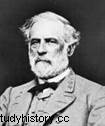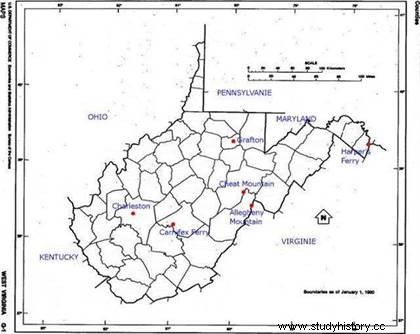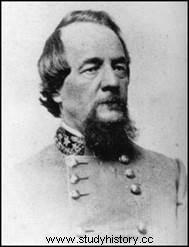 In August 1861, the military situation looks particularly gloomy for the Northerners. The defeat at Bull Run (July 21) sent shockwaves that rocked the Union while cutting short Federal hopes of a quick victory in the main theater of operations, Virginia. That of Wilson's Creek (August 10), if it was not so bitter, nevertheless cost the life of General Lyon, thus putting a stop to the northern advance in Missouri. With Kentucky's neutrality scrupulously respected, the North simply lost the initiative . The ball, at this moment, is in the camp of the South, and this one will endeavor to take advantage of it to reconquer the ground lost in Virginia.
In August 1861, the military situation looks particularly gloomy for the Northerners. The defeat at Bull Run (July 21) sent shockwaves that rocked the Union while cutting short Federal hopes of a quick victory in the main theater of operations, Virginia. That of Wilson's Creek (August 10), if it was not so bitter, nevertheless cost the life of General Lyon, thus putting a stop to the northern advance in Missouri. With Kentucky's neutrality scrupulously respected, the North simply lost the initiative . The ball, at this moment, is in the camp of the South, and this one will endeavor to take advantage of it to reconquer the ground lost in Virginia. A Poisoned Gift for General Lee
After having, in April, refused the command of the federal troops in Washington (a role that would fall to the unfortunate McDowell), Colonel Lee had resigned in the army to serve his state, Virginia, and the latter had rewarded him by placing him at the head of its militia. However, it had gradually been integrated into the provisional army of the Confederation and placed at the disposal of Generals Beauregard and Johnston, in the north of the State. So much so that by August 1861, the Virginian militia was pretty much drained of its substance.Robert Edward Lee, born in 1807, was the eighth child of a Revolutionary War hero (1775 -83), Henry Lee. The latter, cavalry commander, had distinguished himself there and had acquired the nickname of Light Horse Harry ("Harry Light Cavalry"), before serving as Governor of Virginia from 1791 to 1794. Henry Lee died in 1818, leaving his family destitute, and young Robert owed only family prestige the chance to be offered a place in the United States Military Academy at West Point , in New York State. The latter was then one of the best graduate schools in the whole country, and Lee did not miss such a chance, leaving second in his class in 1829. Two years later, he strengthened his social position by marrying a distant relative of the first president. of the United States, George Washington.
The Lees had seven children in all, including three sons who would all serve in the Confederate army, two of them becoming generals there – as well as a distant cousin and one of nephews of Robert Lee. In the years that followed, Lee would pursue a career in the engineering corps . Considered very early on as a future general, he would nonetheless vegetate for a long time, the reduced size of his army (less than 200 men counting the cartographers) and the rigid rules of promotion then in force maintaining him at the rank of captain, despite very meritorious service during the war against Mexico (1846-48). Appointed Superintendent of West Point in 1852, Lee remained there until 1855.
When Jefferson Davis, then Secretary of War, increased the size of the army, notably creating the 2 th cavalry regiment, Lee found himself at the top of the list to become its lieutenant colonel. He therefore left the army in which he had served for a quarter of a century to join his new unit in Texas. Davis would remember Lee and his reputation. In the summer of 1861, he offered him the rank of General in the Confederate Army , which Lee, until then confined to administrative tasks, accepted. However, the newly promoted was to spend most of the war wearing, except on rare solemn occasions, a colonel's uniform:he thought it more appropriate to wait, before wearing the insignia of general, until the end of the war and a "official" promotion in the regular Confederate army.
The Southern president felt that his country had to defend every square inch of its territory:this was an important proof of sovereignty for the overall strategy of the Confederacy, which was aimed at the recognition and support of the European powers, Great Britain in the lead. Lee was therefore charged, in August 1861, with reconquering western Virginia by coordinating the various Southern armies there. This command of importance was a real poisoned gift:poorly trained, his forces were very scattered and few in number . Lee's only chance was to concentrate them to separately confront the small Federal garrisons holding West Virginia.
 West Virginia. Map by the author, based on a background from the site Yellowmaps .
West Virginia. Map by the author, based on a background from the site Yellowmaps . A failed offensive
The Confederate troops deployed in Virginia west of the Appalachians constituted two main forces, the Army of the Kanawha and the Army of the Northwest. The first was under the joint command of John Floyd, the former secretary of war under President James Buchanan, and Henry Wise, John Letcher's predecessor as governor of Virginia. Neither had any military experience, and their forces numbered about 3,500 men in all. They were deployed in the upper Kanawha River Valley, southeast of Charleston, one of West Virginia's major cities. .
The second, larger, numbered a few thousand men and was stationed south of Grafton. Since the death of General Robert Garnett at Corrick's Ford in July, she had been at the command of William Loring. Lee took more or less direct command of it, but he soon found himself faced with a military nightmare :logistical imbroglio, deplorable sanitary conditions and lack of means considerably limited the possibilities of his meager force. An anecdote related by Bruce Catton has it that it was around this time that Lee's hair began to turn white; the general, who until then wore a mustache, wanted to "compensate" by letting his beard grow, but it grew white. Even before Lee arrived, Floyd had taken the initiative to attack in the Kanawha Valley. On August 26, he surprised an Ohio regiment encamped at Kessler's Cross Lanes and routed it. However, he did not take advantage of this easy success to march on Charleston. Instead, he retreated to a defensive position at Carnifex Ferry. A strategic error which allowed the Northerners to mass in the region 5,000 soldiers commanded by William Rosecrans. The latter attacked Floyd's positions on September 10. Despite low losses, Floyd was outnumbered and had been slightly injured:he made a new withdrawal , blaming Wise for being responsible for the loss. Brought much further east, the Kanawha Army would play no more offensive role until it was transferred to Kentucky in early 1862.
 For his part, Lee also took the offensive, targeting the 1,800 men of General Joseph Reynolds, who had established a fortified position atop Cheat Mountain, a towering height. The Confederate commander hatched a complex plan, a pincer attack by three brigades totaling 4,500 soldiers. But the mountainous terrain, the thick forest covering the region, the bad weather, not to mention the inexperience of soldiers who were often sickened by the precariousness of their living conditions, complicated the execution. On September 12, the three Confederate brigades delivered a series of uncoordinated attacks, and their timorous commanders quickly went on the defensive. Northern counterattacks ensued and on September 15, Lee preferred to throw in the towel and retreat. The Battle of Cheat Mountain ended in an undeniable federal success .
For his part, Lee also took the offensive, targeting the 1,800 men of General Joseph Reynolds, who had established a fortified position atop Cheat Mountain, a towering height. The Confederate commander hatched a complex plan, a pincer attack by three brigades totaling 4,500 soldiers. But the mountainous terrain, the thick forest covering the region, the bad weather, not to mention the inexperience of soldiers who were often sickened by the precariousness of their living conditions, complicated the execution. On September 12, the three Confederate brigades delivered a series of uncoordinated attacks, and their timorous commanders quickly went on the defensive. Northern counterattacks ensued and on September 15, Lee preferred to throw in the towel and retreat. The Battle of Cheat Mountain ended in an undeniable federal success . Winter is coming
General Lee had left behind him, to cover his retreat, a small force, commanded by Henry Jackson. Posted on the Greenbrier River, not far from Cheat Mountain, it was attacked there on October 3 by the forces of Joseph Reynolds, who had become emboldened after his previous success. The skirmish was indecisive but, contrary to his hopes, Reynolds was unable to drive the Confederates entirely from the vicinity of his base of operations at Cheat Mountain. Lee took advantage of the time thus gained to try to join the Kanawha army with the bulk of his forces. But the fall weather and difficult terrain took their toll again, forcing Lee to cancel the operation . The general was now facing severe criticism from the Southern press, especially Virginia. Lee had not lost Davis's trust, but the Confederate President soon had no choice but to recall him to Richmond and on October 30, Lee was relieved of his command . On November 3, he was placed at the head of the new military department encompassing Florida, Georgia and South Carolina, where he was notably to prepare the coastal defenses. Davis thus hoped that Lee could be forgotten by spending some time away from the capital.
The general was now facing severe criticism from the Southern press, especially Virginia. Lee had not lost Davis's trust, but the Confederate President soon had no choice but to recall him to Richmond and on October 30, Lee was relieved of his command . On November 3, he was placed at the head of the new military department encompassing Florida, Georgia and South Carolina, where he was notably to prepare the coastal defenses. Davis thus hoped that Lee could be forgotten by spending some time away from the capital.Meanwhile, the command of the army of the North-West fell to Henry Jackson, then to Colonel Edward Johnson. The latter establishes its winter quarters even further south, on a summit called Allegheny Mountain. On December 13, a northern force under the orders of Robert Milroy tried to drive him out. The Southerners kept the advantage , thanks to a judicious use of their artillery and to their commander, who led a bayonet charge at the opportune moment, forcing the Federals to withdraw. A feat that earned him the nickname "Allegheny" Johnson.
 The Northwest Army remained at Allegheny Mountain until March 1862, after which it was moved to first cut off from part of its workforce, transferred to eastern Tennessee. Then, the following month, Johnson was ordered to cross Appalachia to join the Army of the Shenandoah, now commanded by Stonewall Jackson, the hero of the Battle of Bull Run. The Confederacy would never again have the opportunity to reconquer West Virginia, contenting itself with waging a guerrilla campaign there by partisan units. The control of the region by the Union forces allowed the Unionists of Virginia to establish the State of West Virginia there, which would be integrated into the Union in 1863.
The Northwest Army remained at Allegheny Mountain until March 1862, after which it was moved to first cut off from part of its workforce, transferred to eastern Tennessee. Then, the following month, Johnson was ordered to cross Appalachia to join the Army of the Shenandoah, now commanded by Stonewall Jackson, the hero of the Battle of Bull Run. The Confederacy would never again have the opportunity to reconquer West Virginia, contenting itself with waging a guerrilla campaign there by partisan units. The control of the region by the Union forces allowed the Unionists of Virginia to establish the State of West Virginia there, which would be integrated into the Union in 1863. Sources
Biography, very rich in references, of General LeeA brief summary of the Battle of Carnifex Ferry
Brief Summary of the Battle of Cheat Mountain
The autobiography of John Robson, a southern veteran who notably fought at Allegheny Mountain
Article on the history of West Virginia during the Civil War
